Chicory (Cichorium intybus)
Leiwen, river kilometre 158
It is native to Europe, West Asia and Northwest Africa, and has been introduced to Africa, North and South America. In Central Europe it grows in pastures, ruderal areas and fields. It is also quite common in vineyards.
The Romans used the “blue flower” as a medicinal plant. Hildegard von Bingen refers to it as “sunnenwirbel” – the flowers turn towards the sun and close at midday. As early as the 16th century, a distinction was made between garden and field orchids. The cultivated form was said to be “lovelier” for eating – due to the nutritious garden soil, as we know today – chicory reacts strongly to the soil. It is the parent form of chicory salad, radicchio and chicory. From the cultivated form “root chicory”, the roots were first added to bean coffee to give it more colour and bitterness. From the middle of the 18th century it was also used as a “substitute
coffee”. Frederick the Great promoted its cultivation. Only the shoots are used for salad. The beet-like roots are dug in and covered in November. During the winter, firm buds up to 5 cm thick sprout from them – the chicory. The light protection makes them pale and tender.
Many myths of the Middle Ages deal with the chicory. Among the magical powers attributed to it is, above all, the love spell: a chicory under a virgin’s pillow is supposed to make her future husband appear to her in a dream.
The chicory was probably also popular during the Romantic period. The “blue flower” was a central symbol, standing for longing and love and for striving for the infinite, the distant and for wandering. Whether this meant cornflower, heliotrope (Novalis) or chicory? The question is probably too unromantic for romantics. What a heavenly blue! (Source: Wikipedia)
